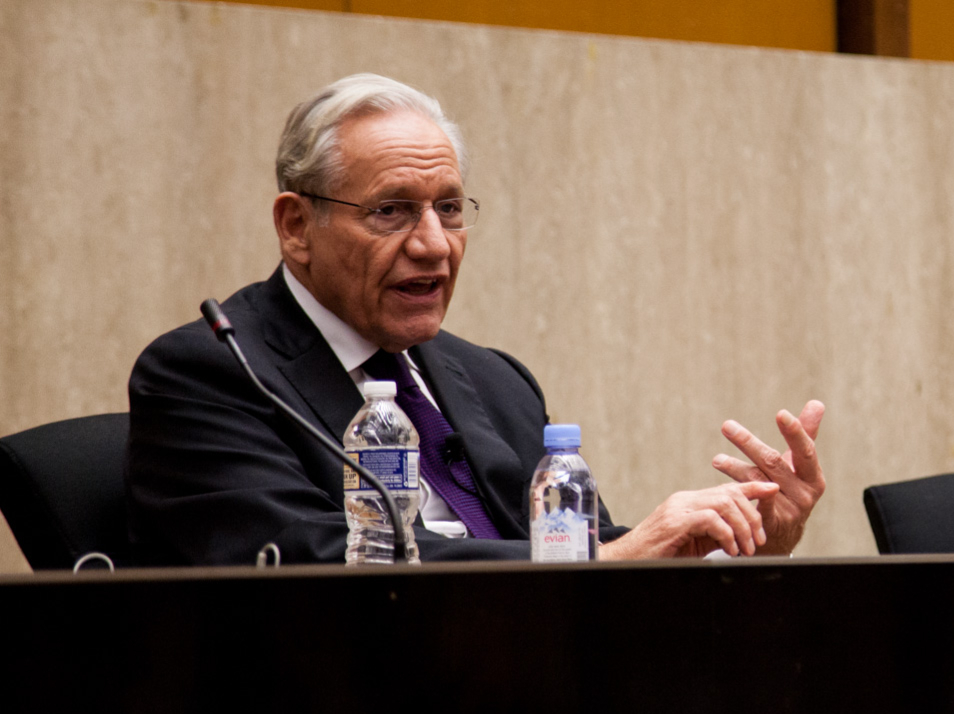First Amendment
The Task of Journalism in a Free Society
Journalism is supposed to respect the truth, and deliver it. It does society no good when journalists embellish facts out of political alarm.

By the summer of 2016, Donald Trump had secured the Republican nomination for president. In the eyes of the elite media, a Trump presidency no longer seemed an outlandish fantasy but rather a menacing if unlikely outcome. Angry and anxious, prominent journalists asked in earnest whether the old norms – report the facts, get the story right, separate news gathering from opining – were still adequate.
The obvious answer should have been yes. One could accurately report Trump’s loopy and alarming statements, his many character flaws, and his dubious policy pronouncements – along with his preternatural ability to give voice to many people’s discontent with elites of both parties – without embellishing the facts, inventing misdeeds, and adopting an oppositional stance.
Instead, having convinced themselves that Trump posed a fatal threat to democracy in America and apparently doubting that citizens could be trusted to evaluate the facts about his candidacy on their own, some of our most prestigious journalistic outlets decided to scrap the old norms. They downplayed or obscured Hillary Clinton’s unlawful use of a private email server to conduct State Department business (including the transmission of highly classified information) while sugarcoating the extraordinary indulgences Clinton and her team received from investigators in the Obama administration FBI and Department of Justice. At the same time, elite journalists took the lead in convicting Trump in the court of public opinion of Russia collusion based on a dossier of tall tales marketed to the public and the FBI by the Clinton campaign.
As part of The 1735 Project – a special RealClearPolitics series that explores the precipitous decline in public trust in the media, the consequences for freedom and democracy, and remedies to the deepening crisis – RCP Washington Bureau Chief Carl Cannon recently revisited questions that journalists raised in 2016 concerning the norms that should guide their coverage of Trump. In “The Art of Covering Politicians Who Lie,” Cannon observed that elite journalists largely concur with the elastic new legal theory advanced by the Biden administration Justice Department’s criminal indictment of Trump for his conduct in relation to the Jan. 6 Capitol Hill riots: A president breaks the law by lying to the public to hold onto power.
Cannon identifies three problems with the theory shared by Special Counsel Jack Smith and prominent journalists. First, it flies in the face of the First Amendment, which above all protects political speech, including political speech that is hateful and untrue.
Second, the theory presupposes knowledge of Trump’s state of mind on Jan. 6. The Oxford English Dictionary defines a lie as “a false statement made with intent to deceive,” notes Cannon. But there is reason to suppose that Trump’s singular personality led him to ignore the chorus of voices on his own staff and instead embrace the far-fetched theories of informal advisers Rudy Giuliani and then-Chapman University Law School Professor John Eastman that the election had been stolen and that on Jan. 6 he was within his rights under the Constitution to challenge the results in the House of Representatives.
Third, as Cannon reminds with several colorful examples – FDR, Nixon, Carter, and Clinton, for starters – U.S. presidents and their loyal minions have routinely uttered falsehoods to the public for political gain. Acknowledging that “Donald Trump presented problems of a whole new order of magnitude,” Cannon also recognized that many Trump supporters take his boasts, embroideries, and outright fabrications – his grandiosity and narcissism – with a grain of salt.
Showing more than telling, Cannon indicates that the old norms were adequate to covering Trump and still furnish the best approach to keeping citizens informed. Select journalists could (and did) accurately report his wild exaggerations, boorish behavior, and ignorance of policy and governance without boasting of their fidelity to a new and higher ethic. The new standards, however, gave many in the elite media leave to embroider Trump’s questionable conduct and participate in the fabrication of treasonous deeds. Adhering to the old norms would have required trust in the public and understanding of the journalist’s vital but limited role in a liberal democracy.
To recover an appreciation of the journalist’s calling, one could hardly do better than read “The Noise of Typewriters: Remembering Journalism,” in which Lance Morrow offers elegiac observations on what journalism once was and restrained ruminations on what it has become.
An award-winning essayist of uncommon perceptiveness and elegance, Morrow provides in “The Noise of Typewriters” a loose and flowing meditation on the mechanics of publishing newspapers and magazines; the peculiarities and indispensable contributions of publishers, editors, and reporters; and the frustrations and joys, the tedium and rush, the private vanity and public spiritedness of writing and disseminating the first draft of history. Bringing a light touch to profound issues and eminent individuals and eliciting striking insights from seemingly casual occurrences and ordinary people, Morrow’s explorations of ideas, events, and people revolve around a simple proposition: The purpose of journalism is to search for and communicate the truth.
A senior fellow at Washington’s Ethics and Public Policy Center whose occasional writings now appear in the Wall Street Journal and City Journal, Morrow joined Time magazine in 1965. Over the course of more than three decades, he covered culture and politics in America and diplomacy and war abroad. The search for and communication of the truth, the veteran journalist well knows, are no simple matters, particularly on a looming deadline.
Nevertheless, “Journalism in the twentieth century proceeded on the assumption that there was such a thing as objective reality,” Morrow writes. “But in the writing and editing, objective reality tended to become subjective reality; facts were well enough, but important facts needed to be evaluated, judged – characterized.”
Accordingly, journalism required both the intelligence to distinguish between the way the world really is and how we would like it to be and the moral character to respect the distinction: “A journalist needs a disciplined reverence for the facts, because the temptations of storytelling are strong and seductive.”
Those temptations, amplified by the reach and convenience of the Internet and social media, have proven difficult to resist. “In the twenty-first century, on the other hand, journalism would find itself plunged into the metaverse,” according to Morrow. “Politics and culture would migrate into the country of myth, with its hallucinations and hysterias – the floating world of a trillion screens. There might come to be no agreed reality at all.”
Morrow is living proof that the temptation to replace the facts with storytelling can be resisted, and his thoughtfully meandering recollections and reflections illustrate why the temptation should be resisted. He returns again and again to the remarkable career of Henry Luce who founded Time along with Life, Fortune, and Sports Illustrated. Through consideration of the publishing mogul’s long tenure at the apex of American journalism, Morrow brings into focus “essential questions – about the nature of journalism, about the politics of storytelling, about the morals of power.”
He admiringly quotes his old friend, Carl Bernstein – half of The Washington Post’s famed Watergate reporting team of Woodward and Bernstein – who said that journalism’s task “was to obtain ‘the best available version of the truth.’” The best available version, Morrow advises, will combine respect for “hard, quotidian, worldly facts” and “the essential truth of things, the inner truth, the poetic truth.” Responsible journalism puts storytelling in the service of the truth.
Morrow illustrates the point in a recollection of the 1964 Georgetown murder of the socialite Mary Pinchot Meyer, which he covered as a young reporter for the old Washington Star. The story was Morrow’s “initiation into certain mysteries of storytelling, and into the follies of conspiracy theories and the truth that sometimes you can never know the truth.”
If he had served on the jury, Morrow states, he would have voted to acquit the defendant: “They never found the gun. There was no evident motive. Two eyewitnesses were on the other side of the canal, a little too far away to be absolutely certain about the man they saw on the towpath.”
Yet the “reasonable doubt” that governs trials is not the last word on the truth. Morrow thinks the acquitted defendant killed Mary Pinchot Meyer.
While the hard, factual truth about Pinchot Meyer’s murderer has proven elusive, Morrow’s graceful storytelling illuminates the larger truth about the truth’s frequent murkiness and refines appreciation of the difference in the kind of judgments that confront jurors and journalists.
With election 2024 approaching, nerves fraying across the political spectrum, and the self-indulgent passions of scorn and resentment all the rage, we could use a thousand more journalists like Morrow – and Cannon – in the national media.
This article was originally published by RealClearPolitics and made available via RealClearWire.
Peter Berkowitz is the Tad and Dianne Taube senior fellow at the Hoover Institution, Stanford University. From 2019 to 2021, he served as director of the Policy Planning Staff at the U.S. State Department.
-

 Executive4 days ago
Executive4 days agoThe Last Supper: New York’s Socialist Feast
-

 Civilization4 days ago
Civilization4 days agoYoo Hoo, VP Vance—Your Character is Showing!
-

 Civilization5 days ago
Civilization5 days agoIvory Tower Thinking and Narcotics Boats
-

 Civilization14 hours ago
Civilization14 hours agoDC Pipe Bomb Arrest Raises Questions About Christopher’s Wray’s FBI
-

 Guest Columns3 days ago
Guest Columns3 days agoCongressional Leaders See Far Higher Stock Returns Than Peers
-

 Civilization4 days ago
Civilization4 days agoFacing Facts & Rolling Back Mythologies: The New National Security Strategy
-

 Civilization2 days ago
Civilization2 days agoThe Legal Logic Behind U.S. Operations Against Narco-Terrorist Networks
-

 Civilization3 days ago
Civilization3 days agoHow Trump Changed America






